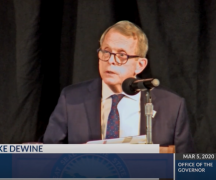By Susan Tebben
Members on both sides of the Ohio legislature are trying to get changes to school funding formulas and testing metrics to stick before the end of the current General Assembly.
House representatives are moving forward with legislation they say will finally address concerns about the state’s K-12 funding formula, the topic of a decades-old decision by the Ohio Supreme Court.
State Rep. John Patterson, D-Jefferson, says House Bill 305 (Haraz Ghanbari, R-Perrysburg is a co-sponsor) is moving forward with “tweaks” and other suggestions made by school districts and state education officials, and he says Speaker Bob Cupp, R-Lima, is committed to bringing the bill to the floor before the end of this year’s House business.
“We have been in very close contact with Speaker Cupp, and he has entrusted me and (co-sponsor state Rep. Gary Scherer, R-Circleville) with continuing the research on the bill,” Patterson told the Capital Journal.
As state representatives figure out school funding, state senators are attempting to extend certain standards set at the beginning of the COVID-19 pandemic in Ohio.
At the end of March, the General Assembly agreed on an omnibus bill that not only put a freeze on EdChoice private school voucher levels, but also waived state testing and report cards for the 2019-2020 school year.
State testing — such as reading and math proficiency exams — are used to gauge the readiness of students to advance to another grade. State report cards grade the school districts and schools on their success rates, and they are used as a metric to determine the state’s share of district funding.
When the House passed the Senate’s bill, then-Speaker Larry Householder, R-Glenford, said putting the usual metrics on hold made sense as the schools figured out the next steps in the pandemic.
“When you look at the report cards, it’s just an unfair situation to try to determine how well a school has done or not done with its students when you’re under this situation,” Householder said.
With Senate Bill 358, state Sens. Teresa Fedor, D-Toledo, and Nathan Manning, R-North Ridgeville, hope to continue the same easing of testing.
In a hearing on the bill last week, Senate Education Committee chair, state Sen. Peggy Lehner, R-Kettering, reminded education officials and committee members that a blanket waiver on testing won’t happen, because federal testing measures are still expected to go on.
Despite the fact that the state doesn’t expect a waiver of federal testing, Lehner said the committee is attempting to work on the impact that testing has on the state’s schools.
“We would still be using those federally mandated tests, we would just change what we want out of them,” Lehner said.
In doing so, Lehner mentioned a possible strategy of not asking for a waiver of federal testing, but a waiver “to remove the accountability piece” from the tests. The only obstacle in that strategy is the requirement from federal education officials that the state still “differentiate” schools in terms of performance, for example.
“I’m just trying to look for a magical thing that’s not ranking,” Lehner said. “I hate ranking, I think ranking is one of the most ridiculous things we do.”
Fedor said she wishes the legislature could have acted on the issues before the beginning of the school year. But now that adjustments have been made in school districts, such as increased technological access and adaptive learning standards, she wants to see the advances continue.
“This is a whole new learning environment,” Fedor said. “We have to build upon these practices that may be better than before, and I’m very interested in modernizing the education world to match the working world.”
The bill will inevitably include amendments, Fedor said, but she hopes to have amendments inserted in the bill by the time Senate meets again for a full session on October 14.
She said through the process, attention must be paid to disadvantaged students, along with those in need of special education, two groups that have arguably seen the most impact during the learning changes forced by COVID-19. With improved infrastructure and communication between districts and parents, the potential is there.
“We’ve equalized the playing field, not completely, but more than we ever had,” Fedor said.
Just as the COVID-19 extension bill seeks to help those most severely impacted by the pandemic’s effects on education, the school funding bill still prioritizes economically disadvantaged districts and individual students.
Patterson said despite the revisions and continuing research going into the bill, the first funding made available under HB 305 would go to those needing it most.
“The school funding formula is such a complex issues, if you make tweaks in one area, you have to see how it ripples out,” Patterson said. “But we recognize the need to assist those students.”
Patterson said he and Scherer met immediately following the House session last week to “consolidate the ideas” they plan to run past the speaker.
The authors of the bill want to hold informal hearings in the primary and secondary education subcommittee, which Patterson chairs, in preparation for consideration by the full House Finance Committee. A timeline still hasn’t been established for hearings.
The legislators are still running simulations, testing the bill’s language against real-time school district funding models and the ability for districts to raise their own share of the operating budget.
“We want to make sure what we’re doing is defensible, is data driven, and is good for Ohio’s children,” Patterson said.
Patterson said the issues between the two bills — testing, report cards and school funding — are all interrelated and it’s important that the issues be treated with attention and consistency, no matter how long it takes to find solutions.
“We’re trying to turn around a large ocean liner here, and it’s going to take some time,” Patterson said.
Neither Cupp nor Scherer were available for comment when asked by the Capital Journal.
***
The CDC sent Ohio a broken COVID-19 test kit in February, letting a virus run wild
On Jan. 2, symptoms kicked in around Ohio for the state’s first residents with COVID-19, a disease caused by the new coronavirus that has infected more than 150,000 residents.
In Ohio, the pandemic had begun — we just didn’t know it yet.
The early infections, which would only be detected via antibody testing long after the disease ran its course through its hosts, were some of the 537 now-documented instances of the coronavirus leaping around Ohio before officials first detected the disease in Cuyahoga County on March 9.
COVID-19 has the potency to kill and the stealth to spread undetected. As such, testing is critical to find and isolate infected people before they seed trains of transmission.
On Feb. 7, the Centers for Disease Control and Prevention sent the Ohio Department of Health a test kit designed to identify the virus. Almost immediately, lab staff hit a wall. They couldn’t verify the test worked. READ MORE
After lawsuit, health department releases COVID-19 faulty test kit emails
After the Ohio Capital Journal filed a public records lawsuit, the state health department released several hundred pages of correspondence with the federal Centers for Disease Control and Prevention.
OCJ requested the correspondence on March 27, after then-Ohio Department of Health Director Amy Acton informed the public that a coronavirus test kit the CDC supplied ODH was faulty.
For several months, ODH neither produced responsive records, cited any exemption to Ohio public records law, nor offered a timeline to do so. READ MORE
Ohio schools ask state supreme court to support armed personnel
Arguing for their right to arm school personnel, 17 schools from 11 counties in Ohio asked the Ohio Supreme Court to allow them to continue using firearms as an option for student safety.
The schools are asking for the state’s highest court to reverse an appeals court decision that said state law did not allow boards of education to allow armed personnel without training on the same level as police and security officers.
Four of the schools came from Shelby County, two each represented Hardin and Montgomery counties, and one district each from Tuscarawas, Williams, Adams, Morgan, Noble, Coshocton and Portage counties were listed on a brief to the court.
Boards of education or governing boards for all but one of the districts have authorized certain staff members to carry weapons within school zones as long as they have concealed handgun licenses. READ MORE





